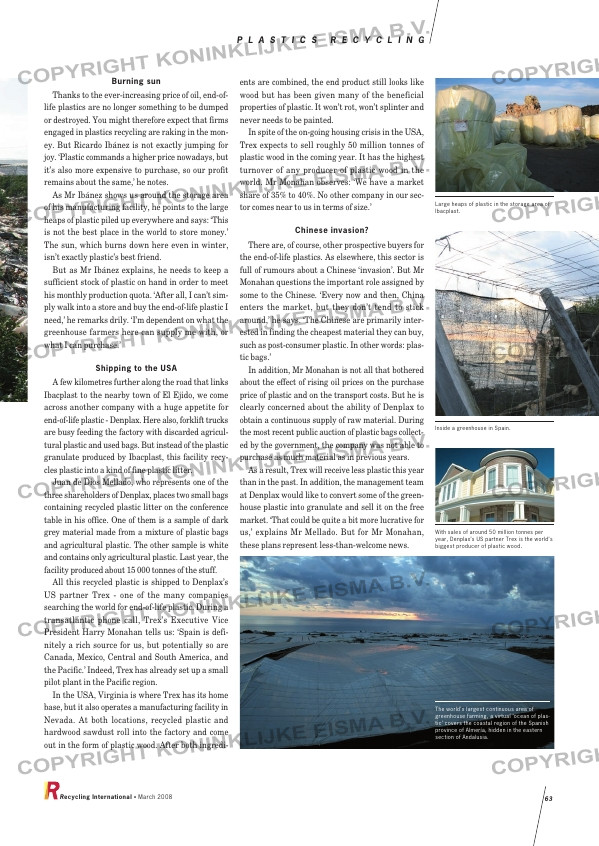Page 63 from: March 2008

Burning sun
Thanks to the ever-increasing price of oil, end-of-
life plastics are no longer something to be dumped
or destroyed. You might therefore expect that firms
engaged in plastics recycling are raking in the mon-
ey. But Ricardo Ibánez is not exactly jumping for
joy. ‘Plastic commands a higher price nowadays, but
it’s also more expensive to purchase, so our profit
remains about the same,’ he notes.
As Mr Ibánez shows us around the storage area
of his manufacturing facility, he points to the large
heaps of plastic piled up everywhere and says: ‘This
is not the best place in the world to store money.’
The sun, which burns down here even in winter,
isn’t exactly plastic’s best friend.
But as Mr Ibánez explains, he needs to keep a
sufficient stock of plastic on hand in order to meet
his monthly production quota. ‘After all, I can’t sim-
ply walk into a store and buy the end-of-life plastic I
need,’ he remarks drily. ‘I’m dependent on what the
greenhouse farmers here can supply me with, or
what I can purchase.’
Shipping to the USA
A few kilometres further along the road that links
Ibacplast to the nearby town of El Ejido, we come
across another company with a huge appetite for
end-of-life plastic – Denplax. Here also, forklift trucks
are busy feeding the factory with discarded agricul-
tural plastic and used bags. But instead of the plastic
granulate produced by Ibacplast, this facility recy-
cles plastic into a kind of fine plastic litter.
Juan de Dios Mellado, who represents one of the
three shareholders of Denplax, places two small bags
containing recycled plastic litter on the conference
table in his office. One of them is a sample of dark
grey material made from a mixture of plastic bags
and agricultural plastic. The other sample is white
and contains only agricultural plastic. Last year, the
facility produced about 15 000 tonnes of the stuff.
All this recycled plastic is shipped to Denplax’s
US partner Trex – one of the many companies
searching the world for end-of-life plastic. During a
transatlantic phone call, Trex’s Executive Vice
President Harry Monahan tells us: ‘Spain is defi-
nitely a rich source for us, but potentially so are
Canada, Mexico, Central and South America, and
the Pacific.’ Indeed, Trex has already set up a small
pilot plant in the Pacific region.
In the USA, Virginia is where Trex has its home
base, but it also operates a manufacturing facility in
Nevada. At both locations, recycled plastic and
hardwood sawdust roll into the factory and come
out in the form of plastic wood. After both ingredi-
ents are combined, the end product still looks like
wood but has been given many of the beneficial
properties of plastic. It won’t rot, won’t splinter and
never needs to be painted.
In spite of the on-going housing crisis in the USA,
Trex expects to sell roughly 50 million tonnes of
plastic wood in the coming year. It has the highest
turnover of any producer of plastic wood in the
world. Mr Monahan observes: ‘We have a market
share of 35% to 40%. No other company in our sec-
tor comes near to us in terms of size.’
Chinese invasion?
There are, of course, other prospective buyers for
the end-of-life plastics. As elsewhere, this sector is
full of rumours about a Chinese ‘invasion’. But Mr
Monahan questions the important role assigned by
some to the Chinese. ‘Every now and then, China
enters the market, but they don’t tend to stick
around,’ he says. ‘The Chinese are primarily inter-
ested in finding the cheapest material they can buy,
such as post-consumer plastic. In other words: plas-
tic bags.’
In addition, Mr Monahan is not all that bothered
about the effect of rising oil prices on the purchase
price of plastic and on the transport costs. But he is
clearly concerned about the ability of Denplax to
obtain a continuous supply of raw material. During
the most recent public auction of plastic bags collect-
ed by the government, the company was not able to
purchase as much material as in previous years.
As a result, Trex will receive less plastic this year
than in the past. In addition, the management team
at Denplax would like to convert some of the green-
house plastic into granulate and sell it on the free
market. ‘That could be quite a bit more lucrative for
us,’ explains Mr Mellado. But for Mr Monahan,
these plans represent less-than-welcome news.
P L A S T I C S R E C Y C L I N G
Recycling International • March 2008 63
The world’s largest continuous area of
greenhouse farming, a virtual ‘ocean of plas-
tic’ covers the coastal region of the Spanish
province of Almería, hidden in the eastern
section of Andalusia.
Large heaps of plastic in the storage area of
Ibacplast.
Inside a greenhouse in Spain.
With sales of around 50 million tonnes per
year, Denplax’s US partner Trex is the world’s
biggest producer of plastic wood.
RI_049 Plastic RI SPAIN:Opmaak 1 28-02-2008 11:55 Pagina 63



